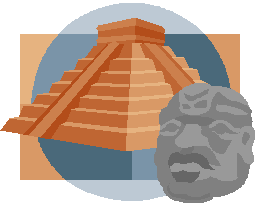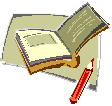Vacation in the Ancient Americas!
A WebQuest for 8th Grade Social Studies
Tiffany Danko
Travis Wall

Introduction | Task | Process | Evaluation | Conclusion | Credits | Teacher Page
Introduction
You are a guide working for Time Tours Inc, which has just opened three new portals to the Ancient Americas, at the height of the Inca, Aztec, and Mayan civilizations. "Vacation in the Ancient Americas" is the company's newest slogan, but the bosses have no idea what's involved or how to describe it to potential time tourists. As the designated guide for the new portals, it's your job to explore the characteristics of these civilizations and develop the materials Time Tours Inc. will need. What was it like to live, work, and play as an Aztec, Inca, or Mayan?
Task
You will be divided up into three groups: Aztec, Inca, and Mayan. Your group's first task is to explore the information available about the Aztec, Inca, and Mayan civilizations. What were they like to live in? Some characteristics to explore include:
- Social structure, including class
- Family life
- The arts
- The economy
- Agriculture
- Religion
- Warfare
- Slavery
- Geography and its effect on the civilization
- Astronomy
- Math
- The rise and fall on the civilization
Your group's goal is to get a broad understanding of the civilization in order to complete your second task, which is developing the materials Time Tours Inc. needs.
Time Tours Inc. needs two products from each group in order to the guides, including yourself, to begin taking time tourists through the portals.
- A brochure about the civilization- what will the time tourists see? Describe the Aztec, Inca, or Mayan civilization using words and pictures in a promotional travel brochure that you, as a guide, can use in selling Time Tours Inc.
- A PowerPoint presentation about the civilization, using words and pictures. You, the guides, will use this to brief your time tourists just before they go through the portal. The goal is to familiarize them with what they will experience at the other end, in the golden ages of Aztec, Inca, and Mayan civilization.
Process
-
Part 1 Researching
- In your groups, brainstorm on what you already know about your assigned culture, the Aztec, Inca, and Mayans. When did they live? Where were they? What were their cultures like?
- Now think about the specific things you will need to know, as a Time Tours, Inc. guide in order to encourage people to take your time-travel tour. What will you need to know about when you get there? Some things include:
- Social structure, including class
- Family life
- The arts
- The economy
- Agriculture
- Religion
- Warfare
- Slavery
- Geography and its effect on the civilization
- Astronomy
- Math
- The rise and fall on the civilization
- Remembering that your group will be developing a brochure and PowerPoint presentation for Time Tours Inc, write down all the topics you plan to research.
- In your groups, choose roles. You are all guides, but many of you have specialties. Someone is the leader of the expedition itself: this person will guide the group as a whole. Another is a biologist, someone is an economist, and another is a historical researcher. Someone else specializes in religion, and one of you has a passion for military history. How do each of you feel as guides- what will you need to research in order to ensure that your specialty is represented in the information presented to time tourists?
- Now begin your research, using some of the resources here. Ensure that you are noting the information you've discovered on the explorer's journal included for you to use a guide. Use the MLA format as a guide for annotating bibliographic or website information.
| Some Culture-Specific Link Compilations for you to Use | General Sources for Ancient Americas Information |
| Aztec | The Smithsonian Institution |
| Inca | National Geographic |
| Mayan |
Time Tours Inc. Guide Journal
Click on image to download word template
Click on image to download web page for journal
Part 2 Compiling
- Now each group should collect their information and compile it into an organization profile of the assigned civilization, describing life in the ancient Aztec, Inca, and Mayan civilizations. What does it mean? How can you use this information to describe your destination to time tourists?
- Now think about your brochure. How can you sell Time Tours, Inc. to people wanting to visit ancient civilizations? What will they want to know? As a group, develop a brochure that describes your assigned civilization. The brochure should be between 2 and 4 pages long, including descriptions and pictures from your research.
- As Time Tours, Inc. guides, you will give a final PowerPoint presentation
to time tourists before they depart for the past. What will time tourists
need to know before they leave? How can you present your information:
A Day in the Life, an Overview, a Comparison with present-day U.S.?
As a group, develop a PowerPoint presentation of at least 10 slides
to give to the class using these considerations. Include your details
from your research, with citations at the end of your presentation"For
further information."
For help with your PowerPoint, check out this On-Line Tutorial
Evaluation
Describe to the learners how their performance will be evaluated. Specify whether there will be a common grade for group work vs. individual grades. You may want to have separate rubrics for individual and group work.
| Beginning 1 |
Developing 2 |
Accomplished 3 |
Exemplary 4 |
Score |
|
|---|---|---|---|---|---|
|
Stated Objective or Performance
|
Description of identifiable performance characteristics reflecting a beginning level of performance. | Description of identifiable performance characteristics reflecting development and movement toward mastery of performance. | Description of identifiable performance characteristics reflecting mastery of performance. | Description of identifiable performance characteristics reflecting the highest level of performance. | |
|
Stated Objective or Performance
|
Description of identifiable performance characteristics reflecting a beginning level of performance. | Description of identifiable performance characteristics reflecting development and movement toward mastery of performance. | Description of identifiable performance characteristics reflecting mastery of performance. | Description of identifiable performance characteristics reflecting the highest level of performance. | |
|
Stated Objective or Performance
|
Description of identifiable performance characteristics reflecting a beginning level of performance. | Description of identifiable performance characteristics reflecting development and movement toward mastery of performance. | Description of identifiable performance characteristics reflecting mastery of performance. | Description of identifiable performance characteristics reflecting the highest level of performance. | |
|
Stated Objective or Performance
|
Description of identifiable performance characteristics reflecting a beginning level of performance. | Description of identifiable performance characteristics reflecting development and movement toward mastery of performance. | Description of identifiable performance characteristics reflecting mastery of performance. | Description of identifiable performance characteristics reflecting the highest level of performance. | |
|
Stated Objective or Performance
|
Description of identifiable performance characteristics reflecting a beginning level of performance. | Description of identifiable performance characteristics reflecting development and movement toward mastery of performance. | Description of identifiable performance characteristics reflecting mastery of performance. | Description of identifiable performance characteristics reflecting the highest level of performance. | |
|
Stated Objective or Performance
|
Description of identifiable performance characteristics reflecting a beginning level of performance. | Description of identifiable performance characteristics reflecting development and movement toward mastery of performance. | Description of identifiable performance characteristics reflecting mastery of performance. | Description of identifiable performance characteristics reflecting the highest level of performance. | |
|
Stated Objective or Performance
|
Description of identifiable performance characteristics reflecting a beginning level of performance. | Description of identifiable performance characteristics reflecting development and movement toward mastery of performance. | Description of identifiable performance characteristics reflecting mastery of performance. | Description of identifiable performance characteristics reflecting the highest level of performance. |
Conclusion
Congratulations! Time Tours, Inc. is now ready to open up a new era in time travel tourism, with daily trips to the golden age of the Aztec, Inca, and Mayan civilizations. And as guides, you've made that possible. You researched information from various websites, evaluating it for relevance and accuracy. You compiled that information, working as a group, to achieve a clear picture of an ancient civilization. You applied that information, putting it into two formats for others to use. Using Word, you developed a brochure that included important details from your research to encourage people to visit these civilizations. Using PowerPoint, you developed and presented a PowerPoint slide show about the civilization, ensuring that our time tourists would know all about the civilization they were visiting.
You've researched the ancient Aztec, Inca, and Mayana civilizations. What happened to them? How did they change, and how are they still with us today, in the governments, societies, and monuments of the Americas? To find out more, check out some of the previous websites, as well as The Library of Congress 1492 exhibit, and The Library of Congress Portals to the World.

Credits & References
Special thanks to:
Dr. B's Atlantis Quest page for inspiration
The Library of Congress and National Geographic for images
For more WebQuest information, see The WebQuest Page and WebQuestDesign Patterns.
"We all benefit by being generous with our work. Permission is hereby granted for other educators to copy this WebQuest, update or otherwise modify it, and post it elsewhere provided that the original author's name is retained along with a link back to the original URL of this WebQuest. On the line after the original author's name, you may add Modified by (your name) on (date). If you do modify it, please let me know and provide the new URL."
Last updated on 27 Jun3 2003. Based on a template from The WebQuest Page

